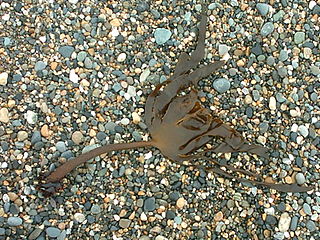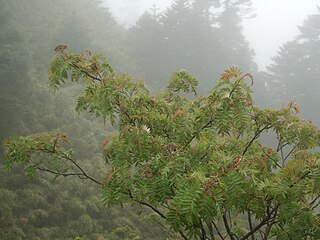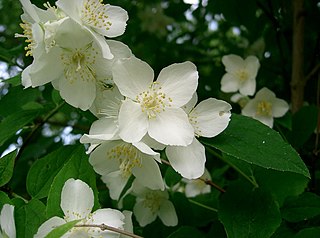
The Araliaceae are a family of flowering plants composed of about 43 genera and around 1500 species consisting of primarily woody plants and some herbaceous plants commonly called the ginseng family. The morphology of Araliaceae varies widely, but it is predominantly distinguishable based on its woody habit, tropical distribution, and the presence of simple umbels.

Ginseng is the root of plants in the genus Panax, such as Korean ginseng (P. ginseng), South China ginseng (P. notoginseng), and American ginseng (P. quinquefolius), characterized by the presence of ginsenosides and gintonin. Ginseng is common in the cuisines and medicines of China and Korea.

The Japanese serow is a Japanese goat-antelope, an even-toed ungulate. It is found in dense woodland in Japan, primarily in northern and central Honshu. The serow is seen as a national symbol of Japan, and is subject to protection in conservation areas.

Eleutherococcus senticosus is a species of small, woody shrub in the family Araliaceae native to Northeastern Asia. It may be colloquially called devil's bush, Siberian ginseng, taiga root, eleuthero, ciwujia, Devil's shrub, shigoka, touch-me-not, wild pepper, or kan jang. E. senticosus has a history of use in folklore and traditional Chinese medicine. Root extracts of E. senticosus are sold as a dietary supplement or cosmetic, usually under the name Siberian ginseng.

Angelica sinensis, commonly known as dong quai or female ginseng, is a herb belonging to the family Apiaceae, indigenous to China. Angelica sinensis grows in cool high altitude mountains in East Asia. The yellowish brown root of the plant is harvested in the fall and is a well-known Chinese medicine which has been used for thousands of years.

Adaptogens or adaptogenic substances are used in herbal medicine for the purported stabilization of physiological processes and promotion of homeostasis.

Lilium auratum is one of the true lilies. It is native to Japan and is sometimes called the golden-rayed lily or the goldband lily.

Zanthoxylum ailanthoides, also called ailanthus-like prickly ash, is an Asiatic plant of the prickly-ash genus Zanthoxylum, natively occurring in forest-covered parts of southeastern China, Taiwan, Southeast Asia, and Japan from Honshu southward. The piquant fruit serves as a local substitute for the ordinary red-pepper in China before the Columbian exchange. In Taiwan, the young leaves are used in cuisines.

Incense in China is traditionally used in a wide range of Chinese cultural activities including religious ceremonies, ancestor veneration, traditional medicine, and in daily life. Known as xiang, incense was used by the Chinese cultures starting from Neolithic times with it coming to greater prominence starting from the Xia, Shang, and Zhou dynasties.

Ecklonia cava, also called paddle weed, kajime, noro-kajime, or gamtae (Korean: 감태), is an edible marine brown alga species found in the ocean off Japan and Korea.

The Yakushima macaque is a subspecies of Japanese macaque that is indigenous to Yakushima Island. It is also known as the Yaku macaque.

In herbal medicine, a herbal tonic is used to help restore, tone and invigorate systems in the body or to promote general health and well-being. A herbal tonic is a solution or other preparation made from a specially selected assortment of plants known as herbs. They are steeped in water and drunk either hot or cool. Herbal tonics are believed to have healing properties ranging from relieving muscle and joint pain and extend as far as inhibiting some cancers.
Eleutherococcus brachypus is a species of flowering plant in the family Araliaceae. It is endemic to China, where it occurs in scrub fields and roadsides on mountain slopes in Gansu, Ningxia, and Shaanxi provinces.

Chengiopanax sciadophylloides is a flowering tree in the family Araliaceae native to Japan. Previously included in the genus Eleutherococcus, it is distinguished from other members of that genus by not having spines or prickles and ITS sequence data confirmed the separation.
Schistomitra funeralis is a moth species in the family Epicopeiidae described by Arthur Gardiner Butler in 1881. It is found in Japan, where it has been recorded from Honshu, Shikoku and kyushu.

Pueraria montana var. lobata, the East Asian arrowroot, or kudzu vine, is a perennial plant in the family Fabaceae.

Sorbus randaiensis is a species of deciduous tree in the family Rosaceae. It is endemic to the mountain areas of central Taiwan, with altitude 1,800m to 3,200m, mostly spotted in the forest of Xueshan, Hehuan Mountain, Mount Xiluan, and Nenggao Mountain. It is a tree 3–8 m tall with white flowers and reddish fruit.
Deutzia yaeyamensis is a species of flowering plant in the family Hydrangeaceae that is endemic to Iriomote in the Yaeyama Islands, Okinawa Prefecture, Japan.

Philadelphus satsumi is a species of flowering plant in the family Hydrangeaceae that is endemic to Japan.

















